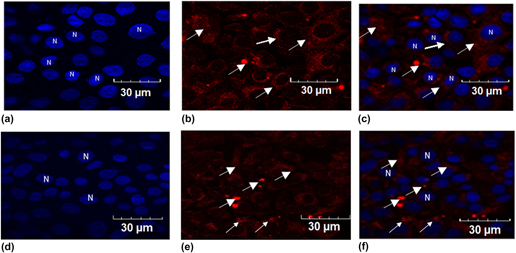Crossref Citations
This article has been cited by the following publications. This list is generated based on data provided by
Crossref.
Runowski, Marcin
Bartkowiak, Aleksandra
Majewska, Monika
Martín, Inocencio R.
and
Lis, Stefan
2018.
Upconverting lanthanide doped fluoride NaLuF4:Yb3+-Er3+-Ho3+ - optical sensor for multi-range fluorescence intensity ratio (FIR) thermometry in visible and NIR regions.
Journal of Luminescence,
Vol. 201,
Issue. ,
p.
104.
Joshi, Bhagyashri
Shevade, Sukhada S.
Dandekar, Prajakta
and
Devarajan, Padma V.
2019.
Targeted Intracellular Drug Delivery by Receptor Mediated Endocytosis.
Vol. 39,
Issue. ,
p.
407.
Malekmohammadi, Samira
Hadadzadeh, Hassan
Rezakhani, Saba
and
Amirghofran, Zahra
2019.
Design and Synthesis of Gatekeeper Coated Dendritic Silica/Titania Mesoporous Nanoparticles with Sustained and Controlled Drug Release Properties for Targeted Synergetic Chemo-Sonodynamic Therapy.
ACS Biomaterials Science & Engineering,
Vol. 5,
Issue. 9,
p.
4405.
Phuong, Ha Thi
Huong, Tran Thu
Vinh, Le Thi
Khuyen, Hoang Thi
Thao, Do Thi
Huong, Nguyen Thanh
Lien, Pham Thi
and
Minh, Le Quoc
2019.
Synthesis and characterization of NaYF4:Yb3+,Er3+@silica-N=folic acid nanocomplex for bioimaginable detecting MCF-7 breast cancer cells.
Journal of Rare Earths,
Vol. 37,
Issue. 11,
p.
1183.
Sharipov, Mirkomil
Azizov, Shavkatjon
Kakhkhorov, Sarvar
Yunuskhodjaev, Akhmadkhodja
and
Lee, Yong-Ill
2019.
Emerging spectroscopic techniques for prostate cancer diagnosis.
Applied Spectroscopy Reviews,
Vol. 54,
Issue. 10,
p.
829.
Tong Zhang
Peng, Guangzheng
Li, Peng
Xiang, Dong
and
Yuan, Xiaoyou
2020.
Effect of Nanostructure and Europium Doping on Fluorescence Properties of YbxMnyOz:Eu3+ Nanotube Arrays.
Russian Journal of Inorganic Chemistry,
Vol. 65,
Issue. 6,
p.
948.
Thu Huong, Tran
Thi Phuong, Ha
Thi Vinh, Le
Thi Khuyen, Hoang
Thi Thao, Do
Dac Tuyen, Le
Kim Anh, Tran
and
Quoc Minh, Le
2021.
Upconversion NaYF4:Yb3+/Er3+@silica-TPGS Bio-Nano Complexes: Synthesis, Characterization, and In Vitro Tests for Labeling Cancer Cells.
The Journal of Physical Chemistry B,
Vol. 125,
Issue. 34,
p.
9768.
Chawda, Nitya Ramesh
Mahapatra, Santosh Kumar
and
Banerjee, Indrani
2021.
Surface-engineered gadolinium oxide nanorods and nanocuboids for bioimaging.
Rare Metals,
Vol. 40,
Issue. 4,
p.
848.
Batool, Rafia
Fatima, Batool
Hussain, Dilshad
Imran, Muhammad
Saeed, Ummama
and
Najam-ul-Haq, Muhammad
2023.
pH-responsive delivery of anticancer galloyl derivatized 5-fluorouracil to MCF-7 cell lines by folic acid functionalized yttrium oxide nanocarrier.
Journal of Drug Delivery Science and Technology,
Vol. 86,
Issue. ,
p.
104708.
Jayamole, Anjusha A.
Ganeshan, Jagan E.
Sundaram, Thirunavukkarasu
Vaippully, Rahul
Roy, Basudev
Mohan, Pandi
Swaminathan, Dhanapandian
and
Narendran, Krishnakumar
2023.
Rapid and one-step mechanochemical ligand exchange of Yb3+/Er3+ co-doped NaGdF4 upconversion nanoparticles for efficient MR and CT imaging.
Zeitschrift für Physikalische Chemie,
Vol. 237,
Issue. 4-5,
p.
617.
Woźny, Przemysław
Soler-Carracedo, Kevin
Perzanowski, Marcin
Moszczyński, Jan
Lis, Stefan
and
Runowski, Marcin
2024.
Bifunctional upconverting luminescent-magnetic FeS2@NaYF4:Yb3+,Er3+ core@shell nanocomposites with tunable luminescence for temperature sensing.
Journal of Materials Chemistry C,
Vol. 12,
Issue. 31,
p.
11824.
Ansari, Anees A.
Parchur, Abdul K.
Li, Yang
Jia, Tao
Lv, Ruichan
Wang, Yanxing
and
Chen, Guanying
2024.
Cytotoxicity and genotoxicity evaluation of chemically synthesized and functionalized upconversion nanoparticles.
Coordination Chemistry Reviews,
Vol. 504,
Issue. ,
p.
215672.
Chávez-García, Dalia
and
Juarez-Moreno, Karla
2024.
Toxicity of Nanoparticles - Recent Advances and New Perspectives.
Li, Bixiao
Ansari, Anees A.
Parchur, Abdul K.
and
Lv, Ruichan
2024.
Exploring the influence of polymeric and non-polymeric materials in synthesis and functionalization of luminescent lanthanide nanomaterials.
Coordination Chemistry Reviews,
Vol. 514,
Issue. ,
p.
215922.
Cinar, Meric Cansu
Gocmen, Mahla Shahsavar
Aciksari, Aysegul
Ceylan, Ramazan
Sahsuvar, Seray
Cetinel, Sibel
Gok, Ozgul
and
Dulda, Ayse
2024.
Upconversion nanoparticles–based targeted imaging of MCF-7 breast cancer cells.
Journal of Nanoparticle Research,
Vol. 26,
Issue. 6,
Li, Yang
and
Chen, Guanying
2025.
Photofunctional Nanomaterials for Biomedical Applications.
p.
247.




